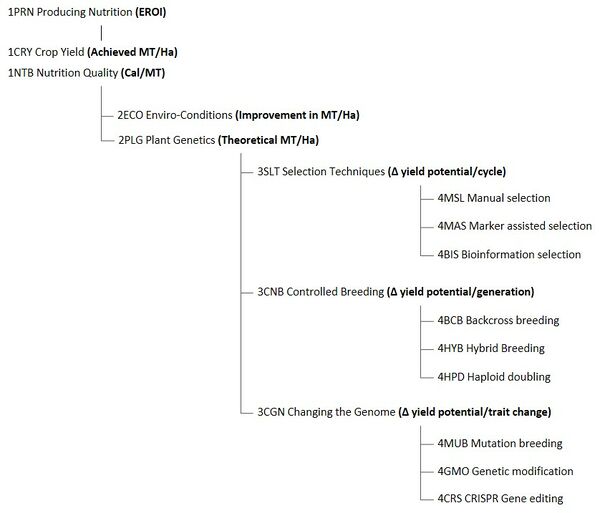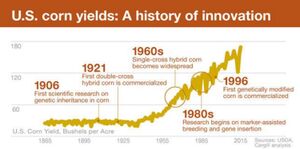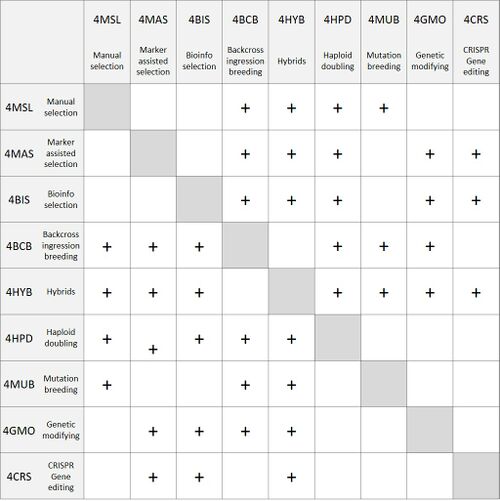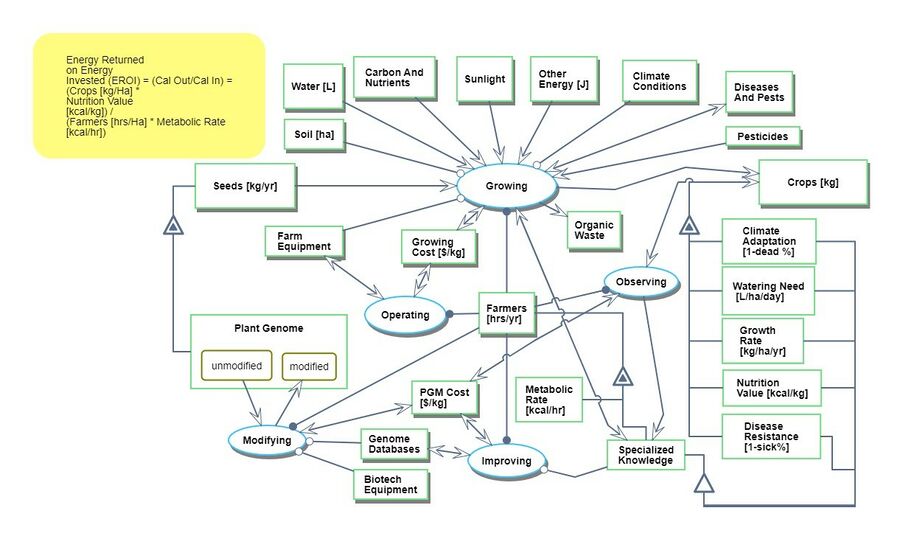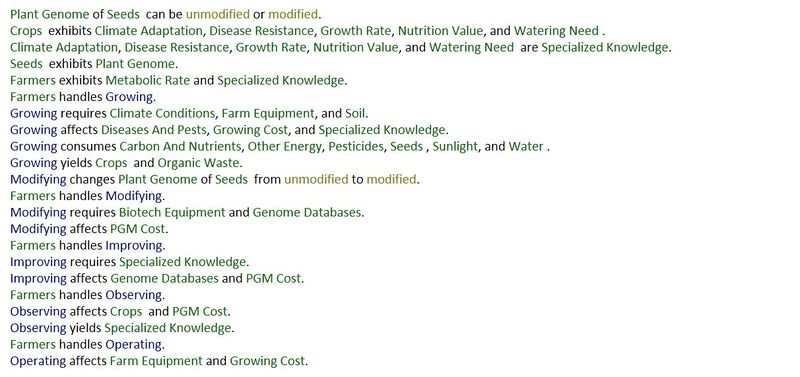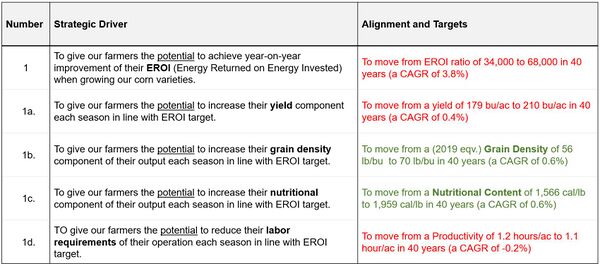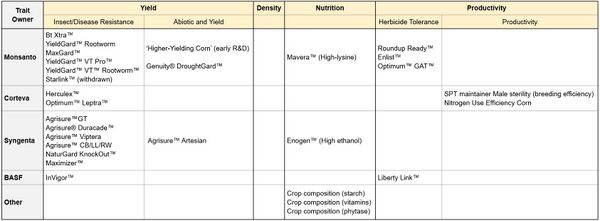Plant Genetic Improvement
Technology Roadmap Sections and Deliverables
The goal of Plant Genetics Improvement is usually to achieve better outcomes in crop production in the form of more Useful Crop Yield. These improved outcomes can be either increased yield, better quality or improved tolerance. The science of Plant Genetic Improvement has traditionally been the domain of the plant breeder. The technology used for Plant Genetic Improvement consists of both tools and methods as shown below:
Our roadmap is focused on the technologies which contribute to improving 2PLG Plant Genetics and the key Figure of Merit (FOM) is Theoretical MT/Ha.
Roadmap Overview
Plant Breeders contribute to increasing Useful Crop Yield (1CRY) and they do this through the science of improving Plant Genetics (2PLG).
Plant Breeders control a genepool in distinct phases - firstly variation - allowing or encouraging wide variability in the genotype, secondly selection of plants with desirable phenotypes (characteristics). Finally plant breeders then aim to eliminate variability from the gene line of the selected plan, in order to produce a consistent gene line for crop production
In summary, plant breeding is based on these key phases: Create variation → Selection → Eliminate variation and the plant breeder achieves this through the major technologies (both tools and methods, with discovery year in brackets) as follows:
- Selection Techniques (3SLT)
- Manual selection (4MLS) a traditional approach which has been carried out for thousands of years.
- Marker assisted selection (4MAS) – a genetic technique where a genetic marker is placed in the genome next to a desirable genetic characteristic which allows desirable plants to be selected before the trait is exhibited in the phenotype. (1986)
- Bioinformatic selection (4DSB) – a bioformatic technique to identify favorable characteristics from the sequenced genetic information of a plant. (2008)
- Controlled Breeding (3CNB)
- Backcross introgression breeding (4BIB) – a breeding technique to move a desirable characteristic from one plant to another line of plants. (1922)
- Hybridization (4HYB) – A natural phenomena where the offspring of purebred parent lines are more healthier than their parents, but themselves sterile. (1926)
- Haploid doubling (4HPD) – a laboratory technique which can create stable parent lines through a laboratory process, rather than seven field seasons of inbreeding. (1959)
- Changing the Genome (3CGN)
- Mutation breeding (4MUB) – a breeding technique which uses primitive methods to force variation in a plant population – for example using exposure to radiation. (1930s)
- Genetic modification (4GMO) – genetic engineering techniques to introduce non-host species genetics into a plant from say a bacteria or different plant species. (1982)
- CRISPR Gene editing (4CRS) – latest genetic technique to be able to cut and paste gene sequences between plants in the laboratory. (2012)
Design Structure Matrix (DSM) Allocation
The DSM is used to show the interaction between tools and methods which make up Plant Genetic Improvement. The + sign indicates that the techniques are compatible and can be used together.
Roadmap Model using OPM
We provide an Object-Process-Diagram (OPD) of the Plant Genetic Improvement roadmap in the figure below. This diagram captures the landscape in which Plant Genetic Improvement belongs and the interfacing systems with which it fits.
An Object-Process-Language (OPL) description of the roadmap scope is auto-generated and given below. It reflects the same content as the previous figure, but in a formal natural language.
Figures of Merit
The table below show a list of FOMs by which plant genetic improvements can be assessed.
Alignment with Company Strategic Drivers
Our company has a vision to provide farmers with seeds which enable them to continually improve their Energy Returned on Energy Invested, and the roadmap relates to technologies which enable this vision.
Of course, there are other growing factors (both inside or outside of the farmers control) which impact Energy Returned on Energy Invested - these other factors are shown on the Roadmap Tree as '2ECO Enviro Conditions'. Therefore, our company can only provide to the farmer the genetic potential to achieve improvement.
In our Plant Genetic Improvement business, we manage a small portfolio of varieties, and an R&D pipeline of new varieties. This is similar to how the pharmaceutical industry manages a pipeline of drugs. Each year our R&D pipeline produces several new varieties with incremental improvements on previous varieties. For this reason, our targets for each driver are shown in terms of a small, statistically-proven percentage improvement over previous varieties.
Positioning of Company vs. Competition
The table below summarizes all the GM traits registered for use in corn in the US. The left-most column shows the owner-company which owns the trait and which is also likely the discoverer. This owner-company can and will be licencing these traits to the other seed companies shown here, and many other small seed companies across the US.
The trait competitive landscape table shows the environment which we face as a small biotechnology start-up which is trying to find a position in the corn trait market. Of course, trait development programs can take 20 years to bring to market (hopefully less with new technology). We must compare the table above, against our company goal which is ‘giving farmers the potential to improve their Energy Returned on Energy Invested (EROI)’ and the drivers of this which are: yield, nutritional content, density and productivity.
- Yield – there are many traits which are designed to ‘protect’ yield from insect and disease damage, and abiotic stress. There is only one trait (in early development) which is actually targeting higher yielding plants directly. Regardless, this is a crowded space and so not an opportunity.
- Density – No traits on market or in development to improve the density of corn. This could be a potential target for our company. Our 16.887 team has conducted interviews with corn breeders in the last few days who suggest that this could be a commercially viable trait, and an achievable breeding target.
- Nutrition – There are several nutritional traits in development or on market – only one focused on starch as a form of energy – this is in early R&D at a university in Spain. In corn, the calorific energy is stored in the form of carbohydrates in the form of both starch and sugars. There is opportunity for our company to pursue this.
- Productivity – There are many productivity traits including the most successful – RoundupReady herbicide tolerance. This is a more challenging target for a small independent biotech company – very often productivity traits involve cross-discipline technology partnerships (for example RoundupReady is a co-discipline technology involving genetics and agrochemicals).
In summary, the competitive chart suggests that our initial R&D efforts should focus on understanding the plant physiological pathways which are responsible for grain density as well as increasing the calorific value of the grain.
Key Publications, Presentations and Patents
A good technology roadmap should contain a comprehensive list of publications, presentations and key patents as shown in Figure 8-19. This includes literature trends, papers published at key conferences and in the trade literature and trade press.
Terminology
- Variety is a specific genetic line which has been improved by plant breeders and genetically stabilized for commercialization. A variety will belong to a seed company and will have a lifetime between a couple of years and a decade. An example variety is P9492AM which is a Pioneer seed variety in Pioneers hybrid family P9492.
- Genetic Modification is a technique of editing the genome of a plant in a way which couldn’t be achieved by conventional breeding. Often using genetic code from a different species.
- Trait isthe term given to describe a specific phenotypical feature, usually beneficial which is expressed by the organism. For example, blue eyes is a trait in humans, whilst glyphosate herbicide resistance is a trait in a corn plant.
- Trait Brand is typically a trademarked name for a trait which has been discovered, commercialized and protected by a biotech company (eg. RoundupReady). The brand will be familiar to farmers, and has a lifetime measured in decades, depending on how long the trait remains competitive.
- Event is a term to describe the insertion of a particular transgene into a specific location on a plant chromosome – an event leads to the plant exhibiting the trait.
